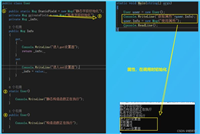c#在调用winapi函数时,可能会看到如下的声明
[structlayout(layoutkind.sequential)]
public struct rect
{
public int left;
public int top;
public int right;
public int bottom;
}
在类或者结构体前面带上了
[structlayout(layoutkind.sequential)]
structlayoutattribute特性的作用是允许你控制内存中类或结构的数据字段的物理布局。
平常我们在c#代码中使用类或者结构体时,不需要使用此特性。但在与非托管代码时交互,需要使用structlayoutattribute特性来控制类型的非托管布局。
structlayoutattribute常用构造函数是:
structlayoutattribute(system.runtime.interopservices.layoutkind)
system.runtime.interopservices.layoutkind是一个枚举类型,有三个取值。
layoutkind.sequential
强制按成员的显示顺序对其进行排列。对于blittable类型,在托管和非托管内存中控制布局。对于non-blittable类型,它会在将类或者结构体封送到非托管代码时控制布局(换言之,如果仅在c#中进行调用,不会做任何操作,在与非托管代码交互时,仅控制送入非托管代码的布局)
layoutkind.explicit
控制每个数据成员的精确位置,这会影响托管和非托管代码中的布局,不管是blittable类型还是non-blittable类型。,使用layoutkind.explicit时,需要使用fieldoffsetattribute特性指示类型中每个字段的位置。
默认情况下,编译器会将layoutkind.sequential应用到结构体,对于类,需要显式应用layoutkind.sequential值。
到这里也就明白了,以后在调用api函数时,如果使用的是结构体,就不再需要下面这句代码了。
[structlayout(layoutkind.sequential)]
下面用示例代码说明一下
这里以获取桌面窗体的宽高为例,需要用到的api函数是
hwnd getdesktopwindow(); bool getwindowrect(hwnd hwnd, lprect lprect );
其中lprect是指向rect结构体的指针,rect结构声明如下:
typedef struct tagrect {
long left;
long top;
long right;
long bottom;
} rect, *prect, *nprect, *lprect;使用结构体时,调用代码如下:
using system;
using system.runtime.interopservices;
namespace consoleapp10
{
public struct rect
{
public int left;
public int top;
public int right;
public int bottom;
}
class program
{
[dllimport("user32.dll")]
private static extern intptr getdesktopwindow();
[dllimport("user32.dll", setlasterror = true)]
private static extern int getwindowrect(intptr hwnd, out rect rc);
static void main(string[] args)
{
intptr hwnd = getdesktopwindow();
rect rect;
getwindowrect(hwnd, out rect);
console.writeline($"left:{rect.left},top:{rect.top},right:{rect.right},bottom:{rect.bottom}");
}
}
}运行结果如下:

下面我们来看一下,把结构体换成类的情况
using system;
using system.runtime.interopservices;
namespace consoleapp10
{
public class rect
{
public int left;
public int top;
public int right;
public int bottom;
}
class program
{
[dllimport("user32.dll")]
private static extern intptr getdesktopwindow();
[dllimport("user32.dll", setlasterror = true)]
private static extern int getwindowrect(intptr hwnd,rect rc);
static void main(string[] args)
{
intptr hwnd = getdesktopwindow();
rect rect = new rect();
getwindowrect(hwnd, rect);
console.writeline($"left:{rect.left},top:{rect.top},right:{rect.right},bottom:{rect.bottom}");
}
}
}运行结果如下:

运行结果并不正常
把类修改一下,带上[structlayout(layoutkind.sequential)]
[structlayout(layoutkind.sequential)]
public class rect
{
public int left;
public int top;
public int right;
public int bottom;
}再次运行,发现结果正常了

最后再看看layoutkind.explicit的情况,调用代码如下
using system;
using system.runtime.interopservices;
namespace consoleapp10
{
[structlayout(layoutkind.explicit)]
public class rect
{
[fieldoffset(0)]public int left; //fieldoffset用于指示类或结构的非托管表示形式中字段的物理位置
[fieldoffset(4)]public int top;
[fieldoffset(8)]public int right;
[fieldoffset(12)]public int bottom;
}
class program
{
[dllimport("user32.dll")]
private static extern intptr getdesktopwindow();
[dllimport("user32.dll", setlasterror = true)]
private static extern int getwindowrect(intptr hwnd,[marshalas(unmanagedtype.lpstruct)]rect rc);
static void main(string[] args)
{
intptr hwnd = getdesktopwindow();
rect rect = new rect();
getwindowrect(hwnd, rect);
console.writeline($"left:{rect.left},top:{rect.top},right:{rect.right},bottom:{rect.bottom}");
}
}
}以上就是c#使用structlayout特性来控制内存结构的操作代码的详细内容,更多关于c# structlayout控制内存结构的资料请关注代码网其它相关文章!






发表评论